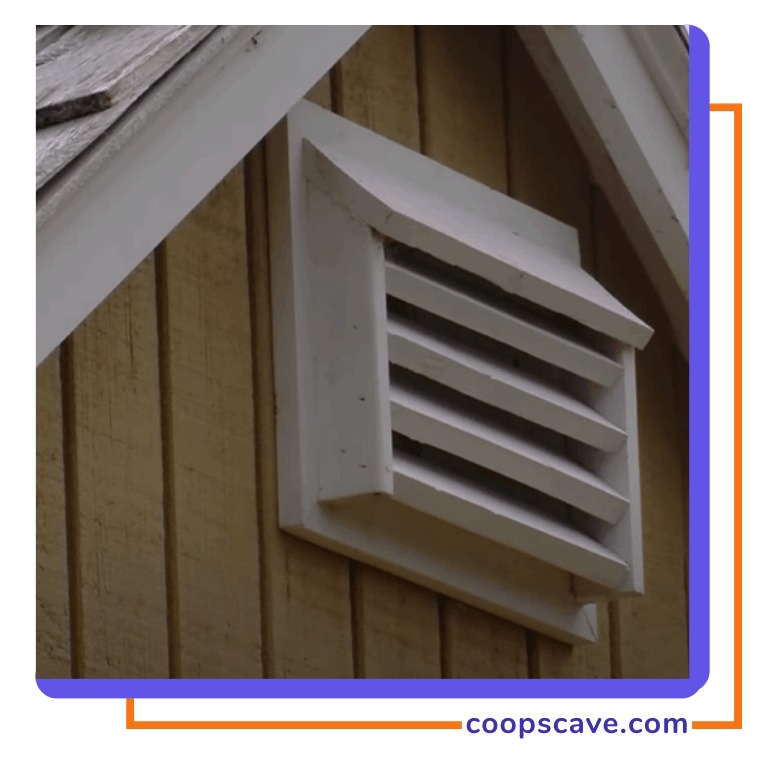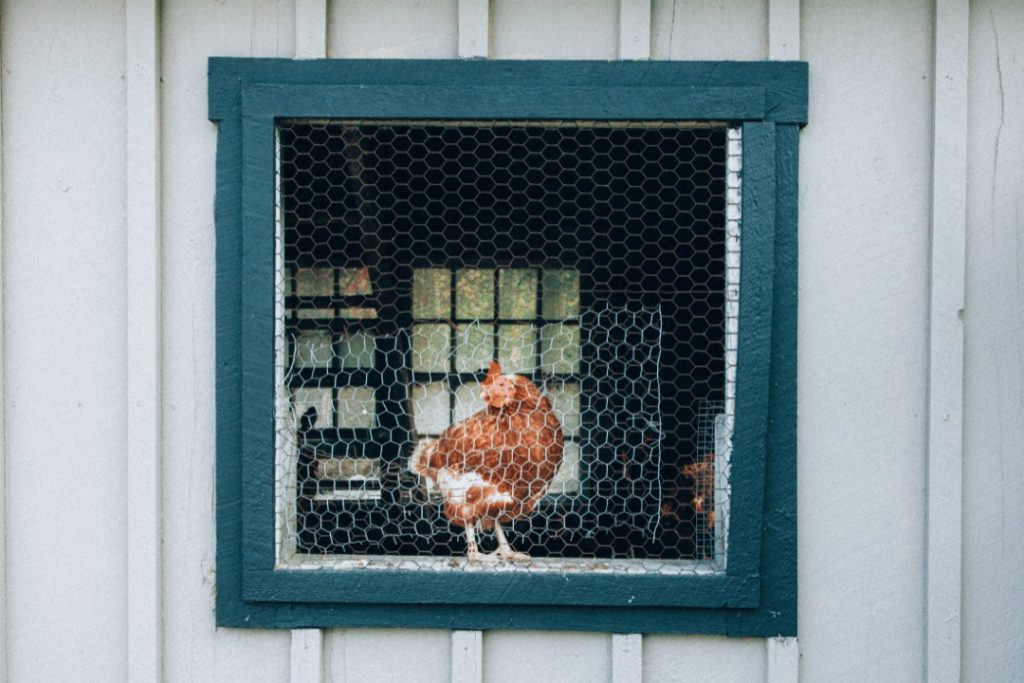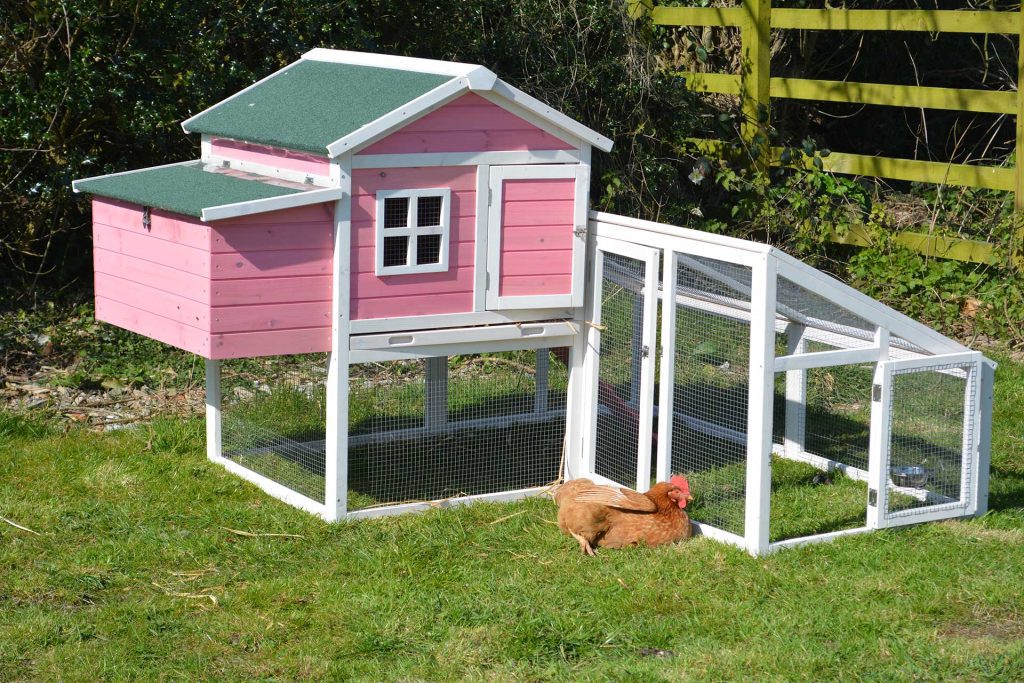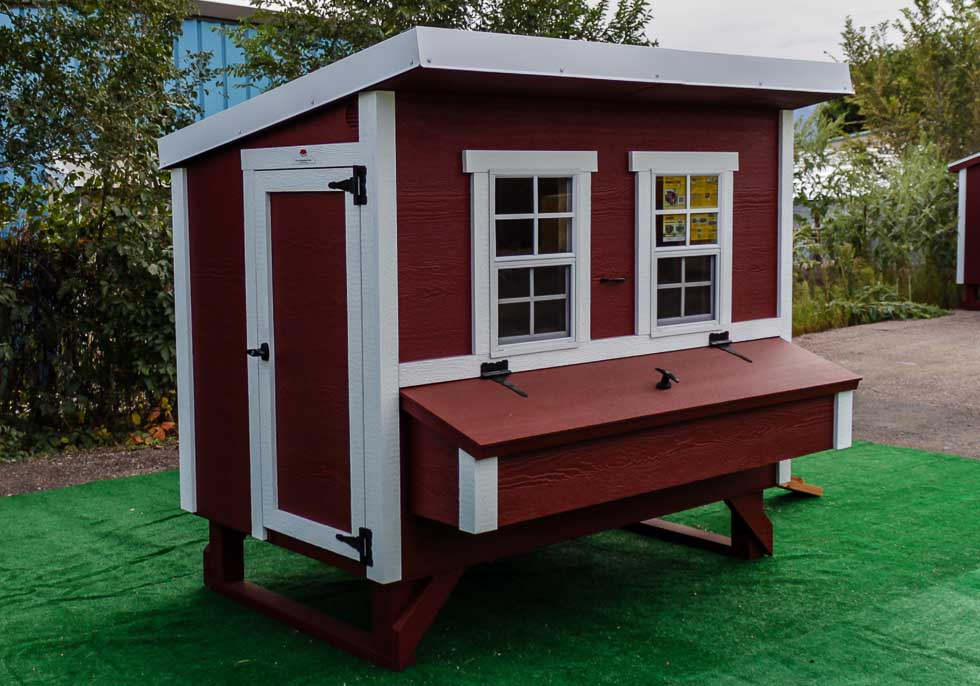Fresh air is crucial for everyone, whether humans, chickens, or any other animal. If you are a chicken keeper, you know that water in significant amounts is released into the air when your birds breathe, poop, or produce waste. Thus it creates moisture and humidity, ultimately making your chicken ill.
Here comes the need for chicken coop ventilation. Proper ventilation in the coop reduces humidity, prevents ammonia build-up, removes frostbite, and solves other pressuring issues. Whether it’s summer or winter, year-round chicken coop ventilation is essential.
To ensure proper airflow for healthier chickens, make multiple windows, add a screen door, make a good pop hole, and add window turbine ventilation. Also, add ventilation holes, and fans, add screen sides, make a house cupola, etc.
Throughout today’s guide, we will explain all details of Chicken coop ventilation. So go through this comprehensive article sharply till the end!
What Are Chicken Coop Vents?
Before discussing the chicken coop ventilation details, you must know what it is. Your chicken coop wall’s holes are the chicken coop vents. Usually, the holes are covered with a weld mesh or hardware cloth. It is to let fresh air in the coop and vermin and snakes out.
Through the vents, the warm stale air comes out of your coop’s top and fresh air in. Usually, the chicken coop vents are sited in large vents pairs or small vents groups, two low down and two high up. The vents ensure the gentle moving of air through your coop without creating a draught.
However, chicken coop ventilation is of two basic types. And those are:
- Forced Air Or Active Ventilation: In the active ventilation process, to power some fans, you must use electricity. It can be costly. Different solar-powered units are also available on the market.
- Passive Ventilation: Naturally, the air is allowed to flow in the passive ventilation. Through your chicken coop, air passes naturally with no force or outside assistance through the passive ventilation system.
Whether you install active or passive ventilation in your chicken coop, ensure it’s easy to see. Its easy visibility is crucial as you need to check the rats and snakes so that they can’t get into your coop.

Importance Of Chicken Coop Ventilation
Chicken coop ventilation is crucial for your chicken because it makes the birds comfortable. The mature chicken stays at 20 and 27 degrees C ideal indoor ambient air temperature. At this temperature range, usually, the mature chicken feels most comfortable.
The ventilation in your chicken coop allows the carbon dioxide, heat, ammonia fumes, and moisture to flow out. And it will enable the fresh air to be in your chicken coop. In excellent weather, chicken remains perfect. But quickly, they will become ill and die if you keep them in unventilated and damp conditions.
You must keep your chicken coop ventilated, especially in cold weather. When the weather turns cold, you need to close down your chicken coop’s windows. Otherwise, moisture will build in your cage, and your chicken can die from the cold.
A crucial element for successful chicken keeping is ensuring sufficient ventilation in your coop. Usually, the poultry keepers frequently make a mistake of not providing adequate airflow in their coop. Due to insufficient air, your birds can become sick quickly.
Generally, birds generate vast amounts of ammonia, moisture, and heat. So to remove the excess heat and moisture from your coop, ventilating it well is essential. Ensuring good ventilation is necessary if your chicken spends their entire day within the cage.
Many newbie chicken keepers believe that it’s better to keep the coop insulated and airtight. But unfortunately, it’s not that much correct. There is no second option of providing massive ventilation in the cage to keep your chicken healthy.
Ventilation is crucial for the following reasons:
- Reduce harmful ammonia fumes
- Supply oxygen-rich air
- Remove excess moisture
- Reduce airborne disease organisms
- Reduce the coop’s inner heat
To learn more details about the ventilation’s importance in your chicken coop, watch this video:
How To Ensure Proper Airflow For Healthier Chickens
To ensure proper ventilation or airflow for your healthier chickens, here are some tips:
i. Make Multiple Windows
The importance of installing multiple windows to ensure better airflow and ventilation is behind the description. Whether you have a big or small coop making multiple windows will ensure your chicken’s good health. Cross-ventilate and use a hardware cloth to cover those windows so that sunlight can come.
For humid summer, an excellent way is cross ventilation. A single window can’t do the cross ventilation’s job as it also wicks away smell and moisture. During winter, sunlight windows are best. And for the warm weather, the small shed windows are best.
ii. Make A Good Pop Hole
In your small coop, the only ventilation system can be a pop hole. The pop hole increases the coop’s airflow.
Therefore especially in hot weather, we recommend you build a larger poop door. You can cover the pop door easily with curtains or sheets in cold weather to protect your birds.
iii. Add A Screen Door
Do you know how a screen door works? Just like a window, the screen door works in the same way. Through the coop doors, huge sunlight can enter. And it ensures a healthier coop environment. You must make multiple screen doors to ensure proper ventilation for healthier chicken.
Remember to cover the screen door with hardware cloth during the winter. Also, add a magnetic screen to keep out the flies from your chicken coop.
iv. Wind Turbine Ventilation
The roof ventilation system is integral to the coop ventilation system, especially in the hot summer. Wind turbine ventilation is easy to install and maintain. To trap the moisture and ammonia, install the air vent aluminum turbine. And keep away the heat from your coop.
iv. Ventilation Holes
Do you know the easiest way of adding ventilation to your coop? Well, it’s drilling holes near your coop’s south and north walls ceiling. Using the hardware mesh, cover the holes to prevent disease. The ventilation holes will clean your coop’s dust and move the inside coop air.
v. Fans
Installing a solar cage or exhaust fan is a simple yet beneficial mechanical ventilation system for your coop. You can install a fan near your coop’s wall or ceiling to move the air. If your coop’s ceiling is high enough, we recommend adding a fan and keeping your birds away.
The fresh air’s other excellent source is windows and wall-mounted fans. All these remove your coop’s dirt and quickly make your cage cool. Increasing the airflow, the fan and window help to vaporize the water.
vi. Make A House Cupola
Make a house cupola on your chicken coop roof to keep away the humid air from your coops inside. Also, it increases the flow of air within your cage. Even in winter, the house cupola keeps your chicken breeds fresh and healthy.
vii. Screen Sides
Looking for another cross-ventilation option? Well, look no further. Removable screen sides are another option for your coop’s cross ventilation. During hot weather, it is very beneficial. The removable screen sides allow maximum fresh air in your chicken cage.
You can adjust this chicken coop ventilation according to the season. However, you must screw it tightly from the outside to keep the predators away.
viii. Floor Register
In the roost level, a sound ventilation system is the floor register. These vents can make your coop cool as they are thin throughout the day and night. To prevent drafts within your coop, install a magnetic cover and close it in the winter.
How Much Coop Ventilation Is Required For Healthier Chickens?
Usually, every day a chicken keeper opens up their coop’s door. But opening your coop’s door for a short time is not enough for ventilation. So the question is, how much is needed? The answer is your chicken requires massive ventilation more than you’d think.
During summer or warm weather, for your coop floor spaces per 10 square feet, you require 1 square foot of ventilation. And in cold weather, your coop’s all open vents should be above the highest roosting point. Also, ensure the ventilation is under a cover in winter so that snow can’t get in it.
When adding ventilation in your coop, there are some essential points to remember, those are:
- Install ventilator with hard/ welded wire in predator-proof area.
- Regularly clean all the ventilators to keep them free from the dust build-up
- During winter, keep your coop draft-free and adequately ventilated.
Even if you ensure good ventilation for your chicken, keeping your coop draft-free is essential. During summer, your chicken will surely appreciate the fresh air.
But in winter, the ventilation can result in the draft build-up in your coop. Therefore above your chicken’s roosting level, place your year-round ventilation high to create a draft-free coop.
Factors To Determine How Much Ventilation A Chicken Coop Requires?
How much ventilation does your bird’s coop require? To determine this consider the following variables:
i. Coops With Organic Bedding VS Inorganic Bedding
The amount of ventilation in your coop depends mainly on its bedding type. Usually, there are two types of bedding that you can use in your cage. And those are organic and inorganic bedding. Coop’s organic bedding means using wood shavings, straw, paper, hemp, etc. And inorganic bedding is sand.
Compared to inorganic bedding, if you use organic bedding, it will create more gas and moisture in your coop. Moisture won’t dry out in the case of organic bedding. That means it will produce more gas, odors, and moisture in your chicken coop’s air. So, it’s evident that organic bedding requires more ventilation.
On the contrary, if you use sand or inorganic bedding, your coop won’t require much ventilation. Sand won’t support pathogenic growth as quickly as the chicken poop dries in it.
ii. Use Of Droppings Boards
Your chicken coop won’t require much ventilation if, under the roosts, you use the droppings board. You can use a droppings board underneath the roosting bars to collect your bird’s nighttime poop or droppings. In the below picture, you can see the dropping board looks like this:

Using a dropping board makes your coop’s dirt cleaning easier. However, using a taping knife easily, you can scrape each day’s poop off into a bucket if you use the dropping boards. Using a tray or dropping board is extremely helpful for your coop.
It helps to remove the chicken poop daily from your coop. Ultimately it helps to reduce a significant amount of moisture, gas, and bacteria from food. So you will require less ventilation if you use the tray or dropping boards in your coop to collect the nighttime droppings.
iii. Frequency of Changing Litter Or Droppings
Your bird’s poopy bedding creates the most moisture, pathogens, and gas in your coop. So, it’s evident that if you frequently remove the droppings and replace the organic bedding, your cage will require less ventilation.
For easy removal purposes, a very effective bedding type is sand. Sand is also very easy to remove and clean.
iv. Climate
Do you know the climate is essential in determining how much ventilation your coop requires?
You must add ventilation in your coop to keep it cool in hot weather. Your coop has more ventilation means, it will remain cooler, and more airflow will have in it. An open-wall enclosure is a must if you live in a hot year-round climate.
One or more walls in an open-wall coop are made from hardware cloth. It will ensure sufficient ventilation in your coop. The following picture will make your concept clear:

v. Coop’s Location
If your coop is located directly under the sun, then during the hot weather, it will require more ventilation. In some areas, trees are tough to find. This means the hot sun will beat down your coop all day during summertime. So to keep your coop from bursting into flames, a very effective method is insulation.
But with the insulation, your coop will become hotter than the coop placed in the shaded area. If you can’t put your coop under the shade, ventilate it well. Enough ventilation will keep your coop cool during summer. And sufficient ventilation ensures more airflow and a better environment within your enclosure.
vi. Ceiling’s Height
A coop with a higher ceiling requires less ventilation. Unwanted gases and moisture in the air concentrate less within the coop with a higher ceiling.
On the contrary, if your enclosure has a lower ceiling, the stale air will concentrate more on the coop. You need to vent large in your coop with a lower ceiling to exist this air.
You may also like to read: The Ultimate Chicken Coop Maintenance Checklist: Monthly, Quarterly, And Annual Tasks
Frequently Asked Questions
How Much Ventilation Do Chickens Need?
In cold weather, 3-4 square feet of ventilation is enough for your chicken coop. But in hot weather, your coop requires additional ventilation. The ventilation can be in the form of vents, windows, and doors.
Should A Chicken Coop Be Airtight?
Continuously your chicken produces ammonia, water vapor, heat, and carbon dioxide. So all times, you need to ensure enough ventilation in your chicken coop.
Some chicken keepers think that during the cold weather, they can keep the coop close. But it’s not true. Even in winter, your chicken coop requires little ventilation.
Why Is Ventilation Important In A Chicken House?
Ventilation prevents the rising of temperature within your coop. Your birds can’t live in excess heat and high internal coop temperature. The ventilation makes the airflow easier and removes the coop’s internal hot.
End Note
So, after all this long, fruitful discussion at the end, we can conclude that chicken coop ventilation isn’t a complicated matter. If you live in a hot climate, you must ensure enough ventilation in your coop. But if you live in colder weather, using less ventilation is enough.
Overnight your chicken leaves a massive amount of poop and droppings, creating tremendous moisture within your coop. Now to get rid of this moisture and gas and to ensure a healthier environment for your chicken, you must add a vent in your cage.
We have already described all details of chicken coop ventilation. If you have any questions, you can ask in the comment box. ASAP, we will reply.



